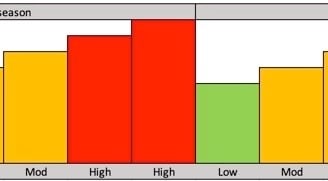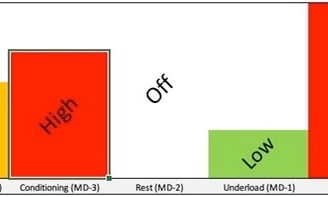Long Term Planning and Organization of On/Off-Field Loading in Academy Soccer
The performance puzzle requires the consideration of all details relating to athlete loading and stress management. The prescription of training is likely optimal if it allows for enough exposure to load that prepares players for the demands of the sport but not too much that there is an increase in injury rates. Now, that begs the question, what is optimal and how many details must be organized, aligned, and interconnected to achieve it? The truth is, no such thing currently exists, however, when it comes to long term planning or periodization there is better and there is worse. Lets start there.
Long Term Planning
When it comes to planning training load across the calendar year more than half the job is already completed for the practitioner. The first step to planning training load is to assess the fixture list for the entire year. Now, every training week cannot look the same from a loading stand point. Training exposure must be navigated between periods of low, moderate, and high loads. If too much time is spent producing high workloads then players will become injured and if too much time is spent at low workloads players will detrain. Therefore, the practitioner must identify the best opportunities to elevate training load throughout the year since the high load is the period that will produce the greatest adaptations. There are a few important items to consider when looking for these windows of opportunities:
· Match’s per week
· Fixture density
· Academic stress
· Monitoring
If there is a 3-week period with two matches, this could be recognised as an opportunity to push the performance envelope. Using the time available to the players to increase training load on and off the field to maximise training effects. On the contrary, if there is a 3 week period with 5 matches scheduled it would be sensible to plan a relief period following this congested time frame. It is important to note that when training objective is to increase load there must be a definition of what constitues peak loading of all key metrics (This will be address in the next section). When the goal is to produce a high training load it is critical to plan the transition to and from these periods and layer prescription appropriately to ensure players are prepared. Therefore to effectively plan to moderate and low load phases there are some reliable guidelines that can be used to project weekly loading to ensure is a steady increase in weekly training demands. Tim Gabbet’s acute:chronic work load (ACWL) ratio can be used as a monitoring tool to project loading and document significant increases between weeks. Workloads that exceed 0.8:1.3 have a reduced risk of injury in comparison to >1.5. This is not to say that the players are guaranteed to get injured with an excess of 1.5, however, it can be used as a tool to document individuals who may be of higher risk.
Weekly total workload prescription
· Sprint Distance: 1 – 1.5 times match average
· High Speed Running: 1.25 – 1.75 times match average
· Total Weekly Distance: 1.5 – 2 times match average
· High Band Acceleration Quantity: 2-3 times match average
· High Band Deceleration Quantity: 2-3 times match average
The above parameters range from low to high weekly load. Training targets across the calendar should wave through these ranges to hit predetermined loading targets. Common methods to gradually elevate training demands are step loading and wave loading. When players return for pre-season to begin the preparation, it is critical to gradually increase loading. There is a siginificant cost to avoiding thoughtful progression and it presents itself in the form of increased injury occurrence and burden. It is critical to leverage data to better inform coaches on the approach to long term training prescription.
Table 1 displays general loading manipulation from pre-season into in-season
When setting up a long term training plan it is also essential to have a corresponding strength program. Lets look at the example above, this step progession plan does not only guide on-field activity but the intensity of speed development, plyometrics, and strength training program. Gradual increases in absolute intensity are alligned with low, moderate, and high system. The highest loads are being prescribed on the high training weeks before transitioning to low load or a relief period.
Weekly Planning
There is a variety of ways to organise training during a lead up to a match. It is common sense to assign the highest load training day during MD-4 or MD-3. This approach is far enough away from matches either side of the week to allow players to train and compete while recovered.
Once the high load training day is determined, moderate and low training days can be oriented around it to promote physical preparation and recovery. It is also important to determine where the weight room sessions will take place in relation to the weekly set up. If there are two weight room sessions per week they would likely take place during the moderate and high training days. The most neurologically demanding training prescription would take place on the high loading day.
Daily Planning and Training Prescription
Assessing the physical outputs of drills using global positioning systems (GPS) is a critical part of meeting targeted outcomes. When working in an academy setting it is highly likely that there will variety within daily drill selection. However, the technical staff and performance team must collaberate to establish staple drills that produce consistent outputs. Therefore, the alternative exercises used within the training set up can be assessed and there contribution to the load sum can be assessed. Alignment between the technical and performance staff in understanding how the technical and tactical focus influences the physical loading. For instance, if the performance staff identified that during 3 sets of 8v8 for 8 minute bouts produces an average of 1600m of jogging, 300m of high-speed running, and 150m of sprint distance for wide midfielders. Introducing conditions such as every restart is a ball played over the top of the defender trigger fast running from the opposing team will accentuate the average intensive metrics. Therefore, planning interventions with the technical staff to modify workload is essential for keeping the players on track.
Training targets for each training day is described below.
Daily workload prescription
· High: 0.55 – 0.75 times average match
· Moderate: 0.35 – 0.55 times average match
· Low: 0.15 – 0.35 times average match
The strength and conditioning programme will also correspond with specific workload ranges. For example, on the high workload day where there is increased volume of high speed running and sprint distance will involve the prescription of intensive plyometrics such as forward bounds or triple hops. Whereas on our moderate day where training has been oriented around increased acceleration, decelerations, and change of direction supplementary training will include lateral bounds or half kneeling jumps. The similarities between the training demands and prescribed exercises are that the physical actions align with the joint angles in which forces are produced.
To conclude, there is not one way of planning and organizing training. However, it is essential to have a way of planning long term load management. This means that outcomes can measured reliably and changes can be managed objectively. It is through consistent practice that practitioner learn more about the training process and gain valuable in what interventions create meaningful change. The practitioners search for “optimal” is likely hopeless, however, as practitioners continue to measure, manage, and modify the training process will advance.




